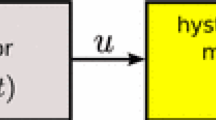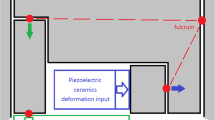Abstract
Updating parameters according to the driving rate of input, the rate-dependent Prandtl-Ishlinskii (PI) model is widely used in hysteresis modeling and compensation. In order to improve the modeling accuracy, two PI models identified at low and high driving rates separately are incorporated through a combination law. For the piezo-driven flexure-based mechanism, the very low damping ratio makes it easy to excite the structural vibration. As a result, the measured hysteresis loop is greatly distorted and the modeling accuracy of the identified PI model is significantly affected. In this paper, a novel time-efficient parameter identification method which utilizes the superimposed sinusoidal signals as the control input is proposed. This method effectively avoids the excitation of the structural vibration. In addition, as the driving rate of the superimposed sinusoidal signals covers a wide range, all the coefficients required for modeling the rate-dependence can be identified through only one set of experimental data. Hysteresis modeling and trajectory tracking experiments were performed on a 2-DOF piezo-driven flexure-based mechanism. The experimental results show that the combined hysteresis model maintains the modeling accuracy over the entire working range of the flexure-based mechanism. The mechanism’s hysteresis is significantly suppressed by the use of the inverse PI model as the feedforward controller; and better result is achieved when a feedback loop is also incorporated. The tracking performance of the flexure-based mechanism is greatly improved.
Similar content being viewed by others
References
Fleming A J, Moheimani S O R. Sensorless vibration suppression and scan compensation for piezoelectric tube nanopositioners [J]. IEEE Transactions on Control Systems Technology, 2006, 14(1): 33–44.
Clayton G M, Tien S, Fleming A J et al. Inversefeedforward of charge-controller piezopositioners [J]. Mechatronics, 2008, 18(5/6): 273–281.
Yong Y K, Liu K, Moheimani S O R. Reducing crosscoupling in a compliant XY nanopositioner for fast and accurate raster scanning[J]. IEEE Transactions on Control Systems Technology, 2010, 18(5): 1172–1179.
Ge P, Jouaneh M. Tracking control of a piezoceramic actuator[ J]. IEEE Transactions on Control Systems Technology, 1996, 4(3): 209–216.
Mayergoyz I D. Mathematical models of hysteresis[J]. IEEE Transactions on Magnetics, 1986, 22(5): 603–608.
Ge P, Jouaneh M. Modeling hysteresis in piezoceramic actuators[J]. Precision Engineering, 1995, 17(3): 211–221.
Ge P, Jouaneh M. Generalized preisach model for hysteresis nonlinearity of piezoceramic actuators[J]. Precision Engineering, 1997, 20(2): 99–111.
Leang K K, Devasia S. Iterative feedforward compensation of hysteresis in piezo positioners[C]. In: Proceedings of the 42nd IEEE Conference on Decision and Control. Maui, Hawaii, USA, 2003. 2626–2631.
Leang K K, Devasia S. Design of hysteresis-compensating iterative learning control for piezo-positioners: Application to atomic force microscopes[J]. Mechatronics, 2006, 16(3/4): 141–158.
Bashash S, Jalili N. Robust multiple frequency trajectory tracking control of piezoelectrically driven micro/nanopositioning systems[J]. IEEE Transactions on Control Systems Technology, 2007, 15(5): 867–878.
Ang W T, Khosla P K, Riviere C N. Feedforward controller with inverse rate-dependent model for piezoelectric actuators in trajectory-tracking applications[J]. IEEE/ASME Transactions on Mechatronics, 2007, 12(2): 134–142.
Park J, Moon W. Hysteresis compensation of piezoelectric actuators: The modified Rayleigh model[J]. Ultrasonics, 2010, 50(3): 335–339.
Choi G S, Lim Y A, Choi G H. Tracking position control of piezoelectric actuators for periodic reference inputs[J]. Mechatronics, 2002, 12(5): 669–684.
Liu Y T, Chang K M, Li W Z. Model reference adaptive control for a piezo-positioning system[J]. Precision Engineering, 2010, 34(1): 62–69.
Ru C, Chen L, Shao B et al. A hysteresis compensation method of piezoelectric actoator: Model, identification and control[J]. Control Engineering Practice, 2009, 17(9): 1107–1114.
Song G, Zhao J, Zhou X et al. Tracking control of a piezoceramic actuator with hysteresis compensation using inverse Preisach model[J]. IEEE/ASME Transactions on Mechatronics, 2005, 10(2): 198–209.
Cruz-Hernandez J M. Phase control approach to hysteresis reduction[J]. IEEE Transactions on Control Systems Technology, 2001, 9(1): 17–26.
Fleming A J, Leang K K. Integrated strain and force feedback for high-performance control of piezoelectric actuators[ J]. Sensors and Actuators A: Physical, 2010, 161(1/2): 256–265.
Liaw H C, Shirinzadeh B, Smith J. Enhanced sliding mode motion tracking control of piezoelectric actuators[J]. Sensors and Actuators A: Physical, 2007, 138(1): 194–202.
Zhong J, Yao B. Adaptive robust precision motion control of a piezoelectric positioning stage[J]. IEEE Transactions on Control Systems Technology, 2008, 16(5):1039–1046.
Zhou J, Wen C, Zhang Y. Adaptive backstepping control of a class of uncertain nonlinear systems with unknown backlash-like hysteresis[J]. IEEE Transactions on Automatic Control, 2004, 49(10): 1751–1757.
Wang Q, Su C Y. Robust adaptive control of a class of nonlinear systems including actuator hysteresis with Prandtl-Ishlinskii presentations[J]. Automatica, 2006, 42(5): 859–867.
Kuhnen K, Janocha H. Inverse feedforward controller for complex hysteretic nonlinearities in smart-material systems[ J]. Control and Intelligent Systems, 2001, 29(3): 74–83.
Author information
Authors and Affiliations
Corresponding author
Additional information
Supported by National Natural Science Foundation of China (No. 51175372) and National Key Special Project of Science and Technology of China (No. 2011ZX04016-011).
QIN Yanding, born in 1983, male, doctorate student.
Rights and permissions
About this article
Cite this article
Qin, Y., Gao, W. & Zhang, D. Rate-dependent hysteresis modeling and compensation of piezo-driven flexure-based mechanism. Trans. Tianjin Univ. 18, 157–167 (2012). https://doi.org/10.1007/s12209-012-1846-y
Received:
Published:
Issue Date:
DOI: https://doi.org/10.1007/s12209-012-1846-y




